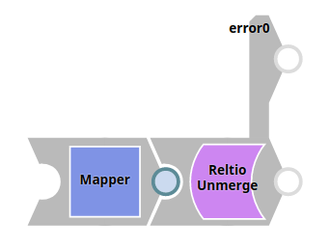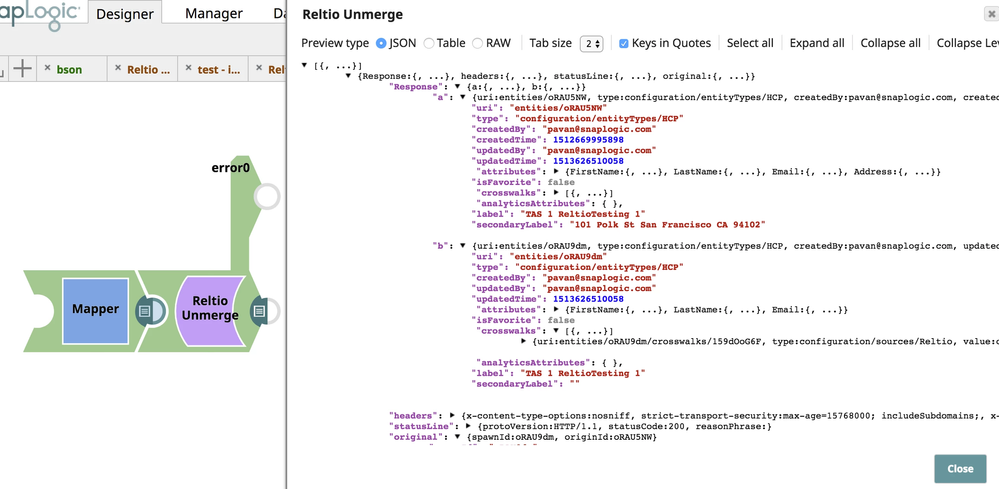| Snap Type: | Write | ||||||
|---|---|---|---|---|---|---|---|
| Description: | This Snap is used to un-merge the merged Reltio Objects (only Entities) on the mentioned Tenant. Based on the Snap's configuration it is also possible to unmerge composite Entities. ETL Transformations & Data FlowThe Reltio Unmerge Snap transforms the merged Reltio Objects into separate un-merged entities. Input & Output
Modes
| ||||||
| Prerequisites: | Reltio account with a valid Tenant Id so that Tenant URL can be formed/API for Account Settings. Also, the Reltio account must have write access in order to be able to create Objects in Tenant. | ||||||
| Limitations and Known Issues | None at the moment. | ||||||
| Configurations: | Account & AccessThis Snap uses account references created on the Accounts page of SnapLogic Manager to handle access to this endpoint. See Reltio Accountfor information on setting up this type of account. Views
| ||||||
| Troubleshooting: | None at the moment. | ||||||
Settings | |||||||
Label | Required. The name for the Snap. You can modify this to be more specific, especially if you have more than one of the same Snap in your pipeline. | ||||||
| Tenant URL | Required. This determines the Reltio host with Tenant Id. The format to be used is https://<reltio_host>/reltio/api/<tenant_id>. Example: https://sndbx.reltio.com/reltio/api/XK178mXYr3UZrG6/ Default value: https://<your_reltio_host>/reltio/api/<tenant_id> This value can be provided dynamically as a pipeline parameter or directly in the Snap but not as an upstream parameter. | ||||||
| Operations | This specifies the type of unmerge operation. Possible allowed values are Unmerge Entities and Not a potential match.
Default value: Unmerge Entities | ||||||
| Origin Entity Id | Required. This parameter describes the composite Entity Id which is the parent Entity ID (similar to Winner Id in Reltio Merge Snap) formed during the merge operation. Default value: [None] This value can be passed either as an upstream parameter or directly in the Snap but not as a pipeline parameter. | ||||||
| Spawn Entity Id | Required. This parameter describes the Entity Id which is the child of merged Entity (similar to Loser Id in Reltio Merge Snap) formed during the merge operation. Default value: [None] This value can be passed either as an upstream parameter or directly in the Snap but not as a pipeline parameter. | ||||||
| Unmerge entity tree | This option can be used for composite Entity, an Entity that is the result of several merge operations. If enabled, every component (contributor) can be unmerged to be a standalone entity again. If not selected, only initial state of spawn without any merges would be unmerged. Default value: Not selected | ||||||
| Retry limit | This determines the maximum number of attempts to get the response. Since Reltio uses the exponential backoff retry policy only for HTTP Status Codes 502, 503 and 504 and no retry policy for HTTP Status Codes 401, 403, 404, 500. Default value: 5 Maximum value: 10 This value can be provided dynamically as a pipeline parameter or directly in the Snap but not as an upstream parameter. | ||||||
| Execute during preview | Executes the Snap during a pipeline Save operation so that the output view can produce the preview data. Default value: Not selected | ||||||
Examples
Basic Use Case
The following pipeline describes how the Snap functions as a standalone Snap in a pipeline:
The Snap is configured with the following parameters:
An example of the output from executing this pipeline:
Typical Snap Configurations
Key configuration of the Snap lies in how the values are passed. The values can be passed:
- Without Expression:
Values are passed directly into the Snap:
- With Expression:
- Using upstream parameters:
Values are passed as upstream parameters:
Advanced Use Case
<to be included later>
Downloads




